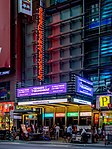5 Times Square

5 Times Square is a 38-story office skyscraper at the southern end of Times Square in the Midtown Manhattan neighborhood of New York City. Located on the western sidewalk of Seventh Avenue between 41st and 42nd Street, the building measures 575 feet (175 m) tall. The building was designed by Kohn Pedersen Fox Associates (KPF) and developed by Boston Properties for Ernst & Young (EY). The site is owned by the New York City Economic Development Corporation, though David Werner and RXR Realty have a long-term leasehold on the building. KPF planned the facade as a glass curtain wall, with large billboards on lower stories as part of the 42nd Street Development Project. The foundation consists of shallow footings under most of the site, though parts of the plot abut New York City Subway tunnels and are supported by caissons. The steel superstructure includes a wind-resisting lattice steel beams, as well as a mechanical core. The building contains 1.1 million square feet (100,000 m2) of floor space, much of which is devoted to offices. The lowest three stories contain retail space and an entrance to the Times Square subway station. During the 1980s and early 1990s, Park Tower Realty and the Prudential Insurance Company of America had planned to develop a tower for the site as part of a wide-ranging redevelopment of West 42nd Street. After the successful development of the nearby 3 and 4 Times Square, Boston Properties developed both 5 Times Square and Times Square Tower. Work started in 1999 after EY was signed as the anchor tenant, leasing the entire building for 20 years. The building opened in 2002. Boston Properties sold the long-term leasehold for 5 Times Square in 2006 to AVR Realty, which resold it in 2014 to a group led by David Werner. RXR Realty purchased a 50 percent ownership stake in the leasehold in 2016 and began to renovate it in 2020.
Excerpt from the Wikipedia article 5 Times Square (License: CC BY-SA 3.0, Authors, Images).5 Times Square
West 41st Street, New York Manhattan
Geographical coordinates (GPS) Address External links Nearby Places Show on map
Geographical coordinates (GPS)
| Latitude | Longitude |
|---|---|
| N 40.755886 ° | E -73.987647 ° |
Address
5 Times Square
West 41st Street
10036 New York, Manhattan
New York, United States
Open on Google Maps











